If you’ve ever wanted to make a world class, authentic-tasting Thai green curry at home, this Thai Green Curry Paste recipe is a must-make!
It’s loaded with fragrant Thai herbs and aromatics like lemongrass, galangal, and Thai green chiles, and is packed with seriously amazing savory and spicy flavor.
We tested this recipe with a variety of tools and spice levels so you can make it using the tools you have at home and tailor the spiciness of your final curry. Plus, it has a great shelf life, so you can whip up a gourmet Vegan Thai Green Curry whenever the mood strikes!
Table of Contents
1. Why make your own Thai curry paste?
2. Why this recipe works
3. Ingredient notes and substitutions
4. Which tool is best for making curry paste?
5. Tips for making this recipe
6. Frequently Asked Questions
7. Recipe card with notes
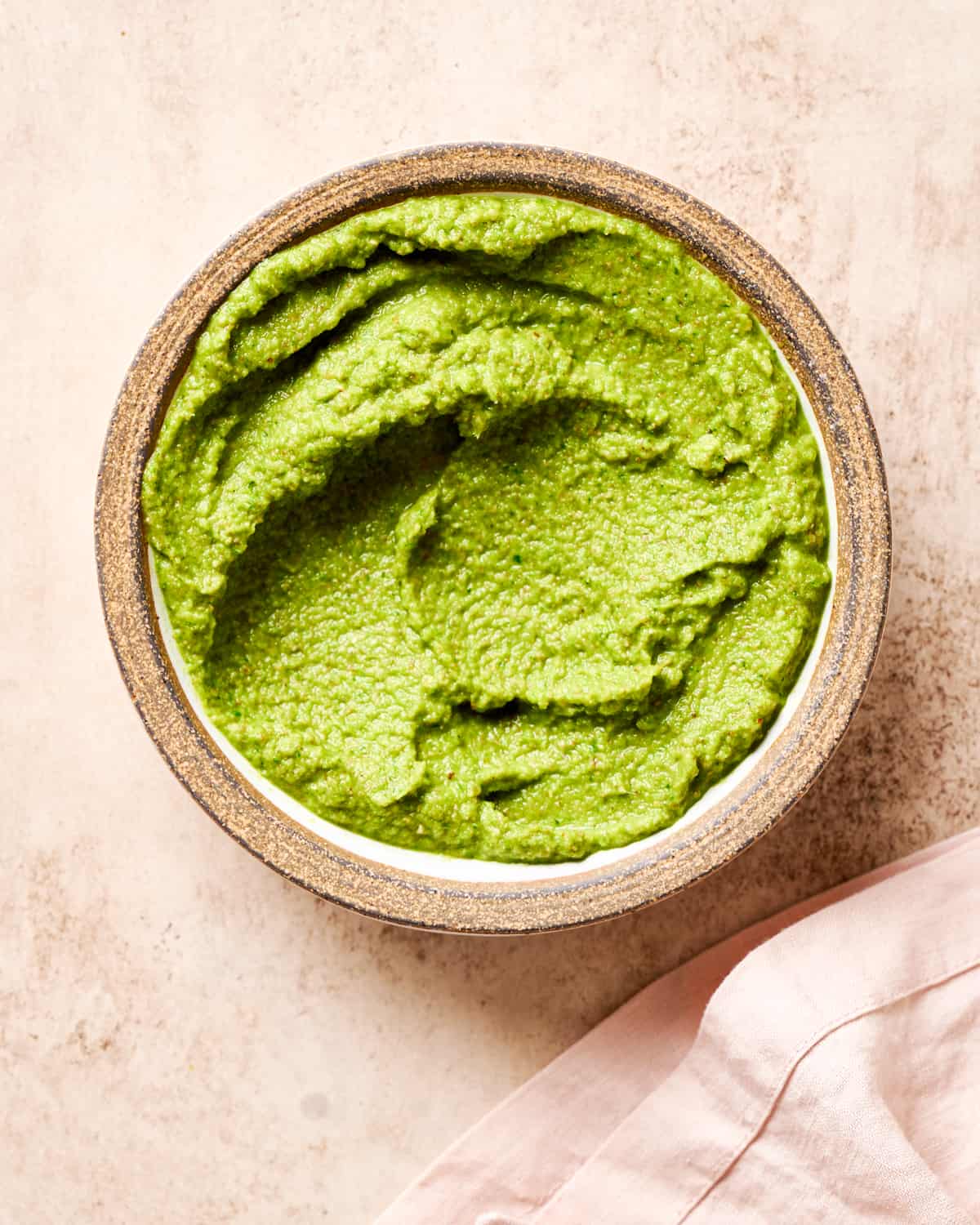
Why make your own Thai curry paste?
You can definitely make a good Thai curry with store-bought curry paste, especially if you use a good brand. But, you’ll never know what incredible Thai curry tastes like unless you make your own paste (or visit Thailand).
Making homemade curry paste is a labor of love, but it makes for a curry that’s seriously supercharged with fresh and intense flavor that you can never achieve with store-bought curry paste.
We tested our Thai Vegan Green Curry recipe side-by-side with (1) this homemade paste and (2) store-bought paste.
Version 2 was, no doubt, very good, but in Version 1, you could taste more layers of flavor, from the intoxicatingly citrusy flavors of lemongrass and lime leaves to the fragrant warmth of the spices and the pungency of the fresh chiles and garlic.
Version 1 was also fresher and brighter, no surprise since jarred curry paste might sit on the shelves for months.
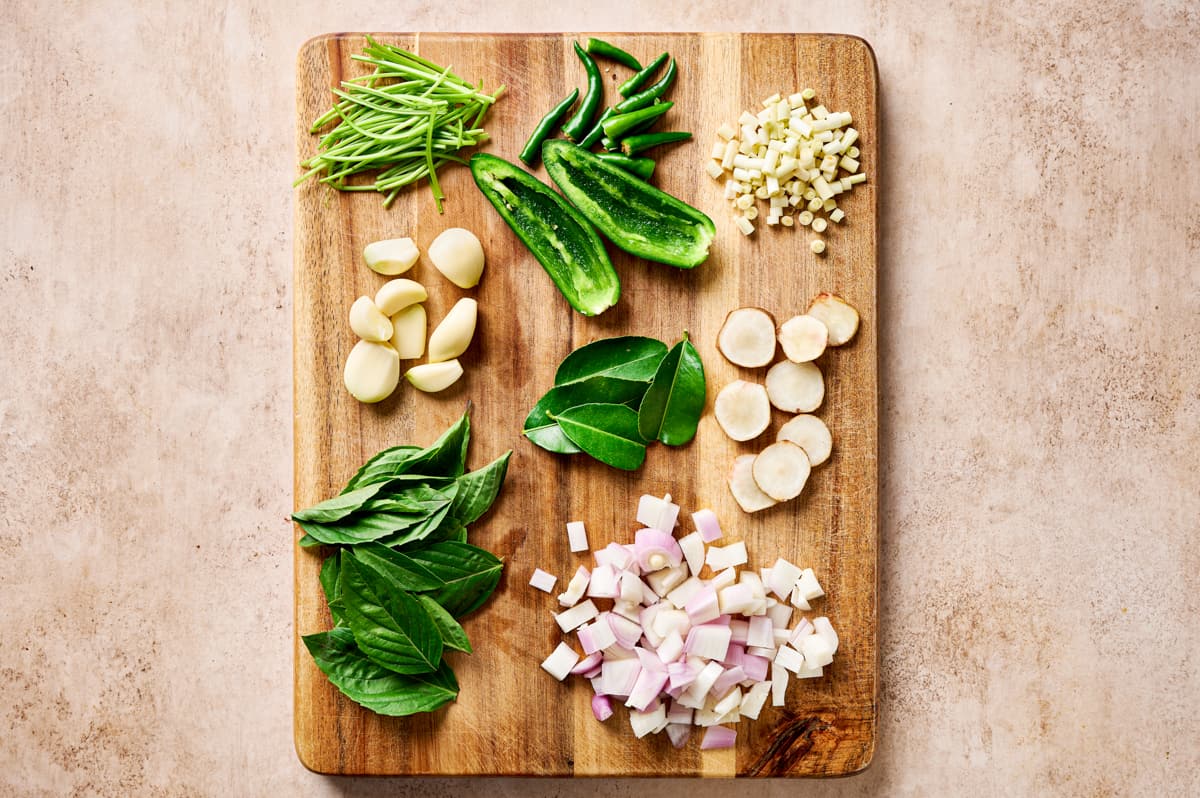
Why this recipe works
Traditional and gourmet Thai flavors.
After days of research, watching YouTube videos, taste testing store-bought green curry pastes, and ordering green curry from several local Thai restaurants, I’m confident that this vegan Thai green curry paste is as traditional and as delicious as possible.
It makes for a world class Thai Green Curry that will truly wow your palate!
Multiple tested methods for making this.
The traditional method of making Thai curry paste is to pound the ingredients with a mortar and pestle, but it’s very time consuming (takes at least 1, if not 2 hours).
We tested this curry paste using a few quicker methods so we could provide precise tips. Skip to the section on “Which Tool?” for our results & recommendations.
Easy to make a big batch + long shelf life.
With a high-powered blender or good-quality immersion blender, this green curry paste is surprisingly easy to double or triple. Which means you can whip up a gourmet restaurant-quality Thai curry pretty quickly the next time(s) around.
The curry paste stays fresh without any flavor loss for a week in the fridge (up to two weeks in the fridge with minor flavor loss), or in the freezer for 3 months.
Ingredient notes and substitutions
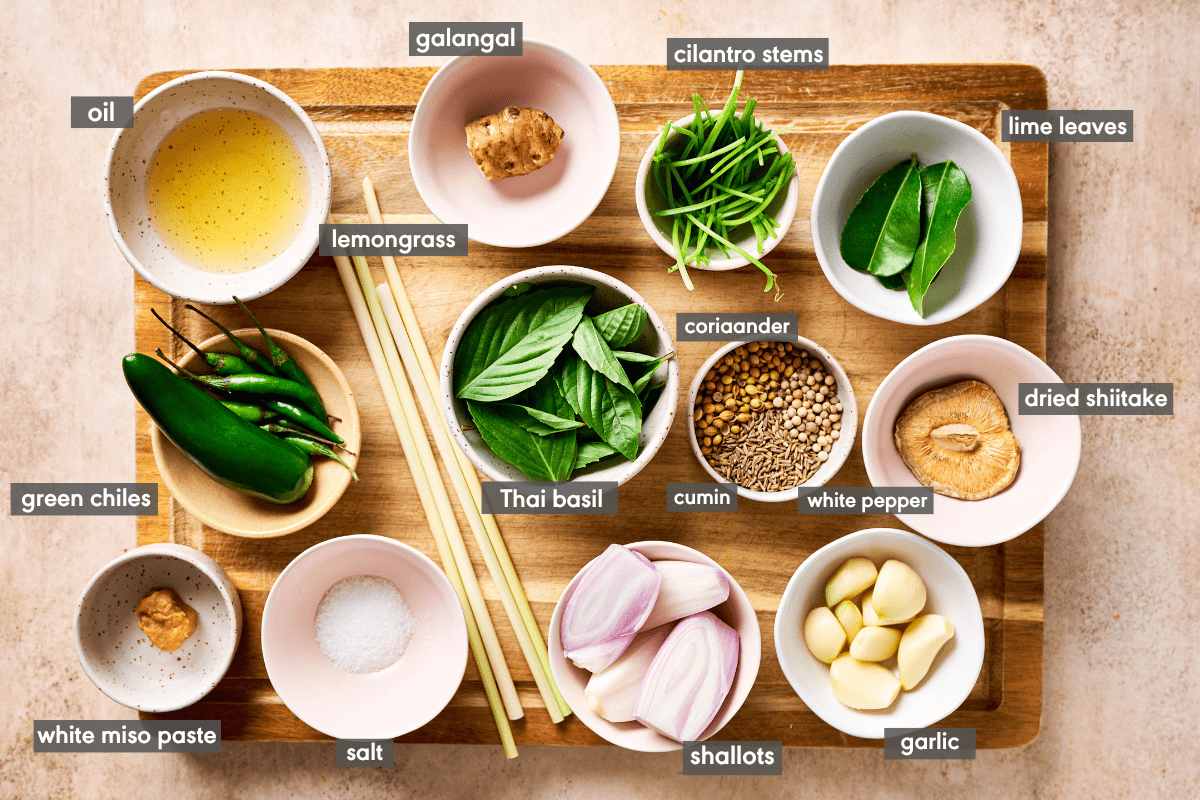
Bird’s eye chile peppers. AKA Thai chile peppers. Similar to the chile peppers traditionally used in Thailand. They also lend the green color to the curry paste, as well as heat and a fresh, fruity aroma.
Substitute: These are very spicy! Check out the Tips section and how to moderate the spiciness level.
Lemongrass, galangal, shallots. Sort of the “holy trinity” of Thai cooking and the flavor base for many dishes.
Lemongrass adds a unique lemony, minty, and gingery flavor. Galangal is often mistaken with ginger but is quite different. Ginger is warm and spicy, while galangal is cooling with a camphor, pine-y aroma.
Cooking Tip: Galangal can have a very hard exterior, so use a sharp knife when slicing it and cut off any hard knobs; angle your knife as needed so you don’t cut through the root.
More galangal tips can be found in this video from Thai cooking creator Pailin’s Kitchen.
Substitute: Frozen sliced galangal can be found at some Asian grocers. If not available, use fresh ginger plus the zest of ½ medium lime. It lends a different flavor but still tasty.
Lime leaves. Fresh lime leaves perfume the entire dish with refreshing, unique citrusy notes. Typically, the zest of makrut limes is used in green curry paste, but those are hard to find.
Substitute: Look for frozen lime leaves at some Asian grocers. If not, use the zest of a medium lime. Again, it’s not the same flavor but it’s the best alternative option widely available.
Cilantro roots or stems. Traditional green curry paste contains the white roots from cilantro, but this is hard to find. I use cilantro stems with great results.
White miso + dried shiitake mushroom: Most traditional Thai curry pastes contain shrimp paste for umami. To keep things vegan, I use a combination of white miso paste—a fermented soybean paste—and a dried shiitake mushroom, two powerful plant-based sources of umami.
Tip: For the dried shiitake mushroom, grate it using a microplane, or blitz it in a spice grinder until powdered.
Substitute: If you have vegan fish sauce, you can try that instead of miso. No dried shiitake? Double the miso.
Spices. Thai green curry paste typically contains coriander & cumin seeds and white peppercorns. If you don’t have these whole spices, there are ground spice conversions in the recipe card.
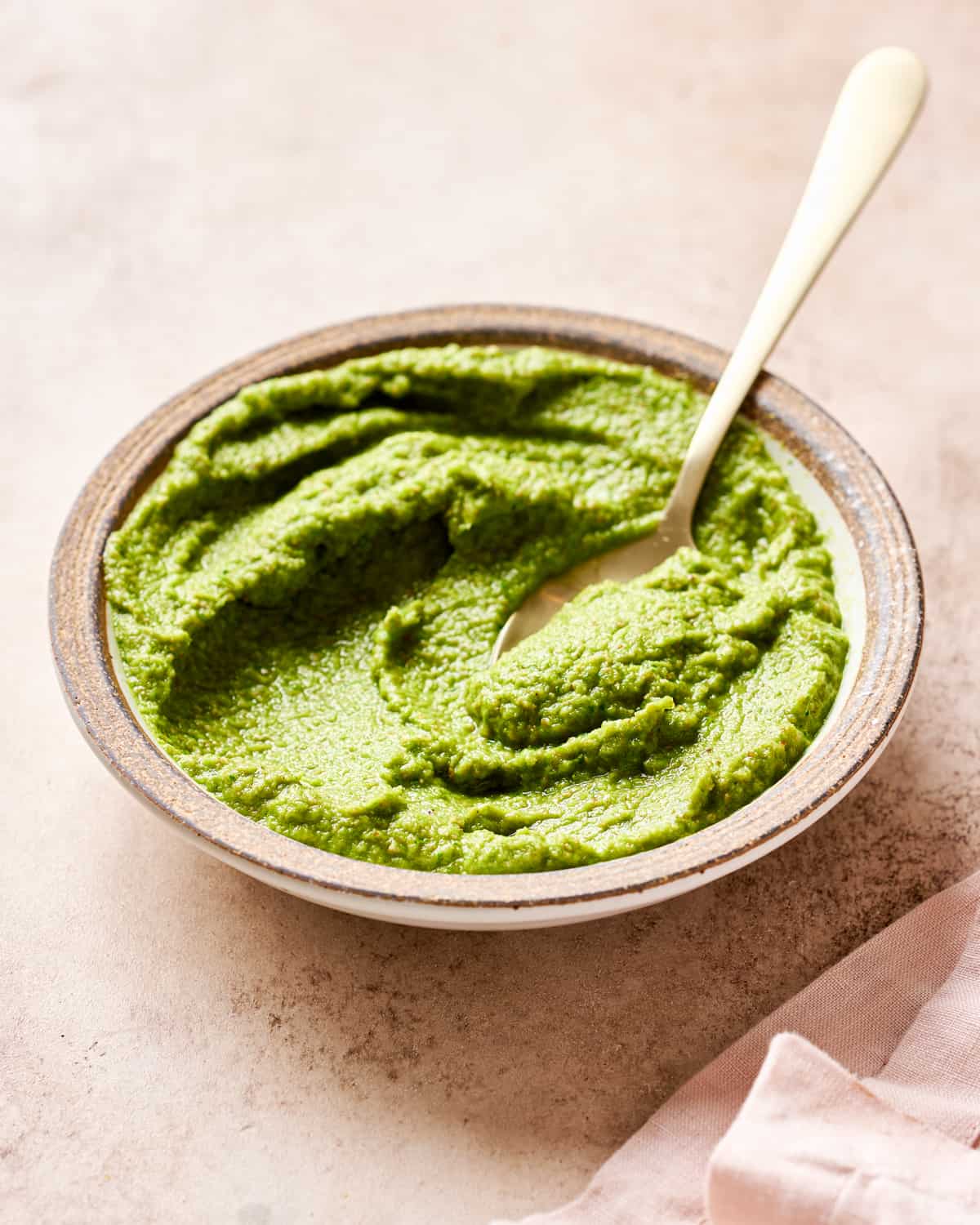
Which tool is best for making curry paste?
TLDR: If you have a small-capacity high-powered blender (method 2), that is my best recommendation, as it’s quickest (~15 min total from start to finish) and brings a smooth texture.
A small-capacity blender container is 32 ounces (1L) or smaller.
Method 1: Mortar and pestle
This is the traditional method, but it’s very time consuming (takes 1 to 2 hours) and requires serious arm muscle. If you want to still go for it, follow this order of operations:
Order of operations for mortar & pestle
- Finely slice or dice your aromatics.
- Grind the toasted whole spices (or use pre-ground spices).
- Add the chile peppers and salt to a mortar and pestle and pound finely.
- Add the sturdy aromatics—lemongrass, lime leaves, galangal, cilantro stems, Thai basil—and pound again. If the mixture gets too wet, add in the ground spices to create friction.
- Add softer ingredients, like garlic and shallots, as well as miso and grated dried shiitake, and pound into a fine paste.
- NOTE: No oil is needed when using a mortar and pestle, as the paste will (very slowly) come together on its own.
Method 2: High-powered small-capacity blender
This is my preferred method. You must have a small blender container (about 32 ounces / 1L or smaller, like this for a Vitamix, this for a Ninja, or a separate cup like this one, etc.).
If you only have a medium-sized blender container (e.g., 48 ounces/1.5 L), you need to double the curry paste.
If you only have a large-sized blender container (64 ounces/2L or bigger), you need to triple the curry paste so it can blend well.
Don’t worry, though, that’s not bad news! This curry paste has a long shelf life so you can make homemade Thai green curry in much less time.
Instructions for high-powered blender
- Chop the peeled tender lemongrass parts and slice the galangal. Grate the shiitake mushroom. Everything else, you can keep whole.
- Add the oil to the blender first so it coats the blades.
NOTE: A little oil is necessary to bring everything together in an electric machine. We tried water instead, but it watered down the flavor and texture so don’t use that.
- Add the remaining ingredients on top of the oil.
- Start blending on low speed, using the blender’s tamper or a similar tool to push everything down, then gradually increase the speed to high. Use the tamper to move up and down constantly.
NOTE: You must have your blender lid in place in order to use the tamper. Otherwise, the tamper can hit the blades and shred.
- Occasionally, stop the blender, and use a silicone spatula to scrape everything down a few times. It should be smooth and look like pureed avocado by the end.




Method 3: Immersion blender
If you have a good-quality, strong immersion blender, you can use that.
INSTRUCTIONS for immersion blender
- Finely chop all of the ingredients first. For galangal and lemongrass, really finely chop (or grate using a microplane or grater). Grate the dried shiitake.
- Grab a wide-mouth mason jar or similar jar that your immersion blender will fit in.
- Place all of the ingredients in the jar, adding the oil on top at the end.
- Place the immersion blender on top of the ingredients and push down to the bottom. Lift up, and using a silicone spatula, scrape all the ingredients together again. Repeat this process until smooth; it will take several rounds and several minutes.
Method 4: Food processor (not ideal)
Most food processors for the home kitchen aren’t strong enough to make a curry paste totally smooth. The flavor is still excellent, so if you don’t mind slight texture in your curry, you can use one.
Finely chop all the ingredients, especially lemongrass and galangal. As with the other electric methods, use the oil to help bring everything together.
Tips for making this recipe
Making your own Thai curry paste at home takes some time and effort, but I promise you it is definitely worth it once. It is incredibly flavorful and makes for a spectacular Thai Green Curry. Read on for maximizing your success in the kitchen.
Make a double or triple batch.
This curry paste will stay good in a sealed jar in your fridge for 1 to 2 weeks, or can be frozen for 3 months. That way, you can enjoy gourmet Thai curry in very little time!
The frozen curry paste doesn’t diminish the flavor of the final curry! Plus, most of the aromatics and herbs can be frozen to use later. Skip to the FAQ section for details.
Tailor to your spice level.
Please read on so your final green curry doesn’t end up too spicy for you!
Spicy version: Use 8 to 12 green bird’s eye chile peppers peppers (~12 to 20g) PLUS 1 jalapeño pepper (~25 to 30g) with membranes removed. This is about a level 7 on the 1-10 scale at a legit Thai restaurant.
Disclaimer: This is spicy so use this only if you can hang with spicy food!
Mild heat: Use 2 to 3 jalapeño peppers (remove most of the membranes) and ½ of a small green bell pepper.
Moderate heat: Use 4 to 6 green bird’s eye chile peppers and 2 jalapeños with membranes removed.
If you can’t find bird’s eye chile peppers but want heat, use 45g of other green chiles: about 3 serrano peppers (remove some membranes to moderate the heat). Or, 2 to 3 jalapeño peppers with the membranes.
Protect your eyes.
Don’t stick your face right above the blender, as the capsaicin in the peppers can make your eyes burn and make you cough.
Grind the spices, if you can.
Grind toasted whole spices with an electric spice grinder or mortar and pestle before adding them to the other ingredients for a silky, smooth consistency. If you don’t mind some bits of texture and you have a high-powered blender, you can skip this step. Or, use pre-ground spices.
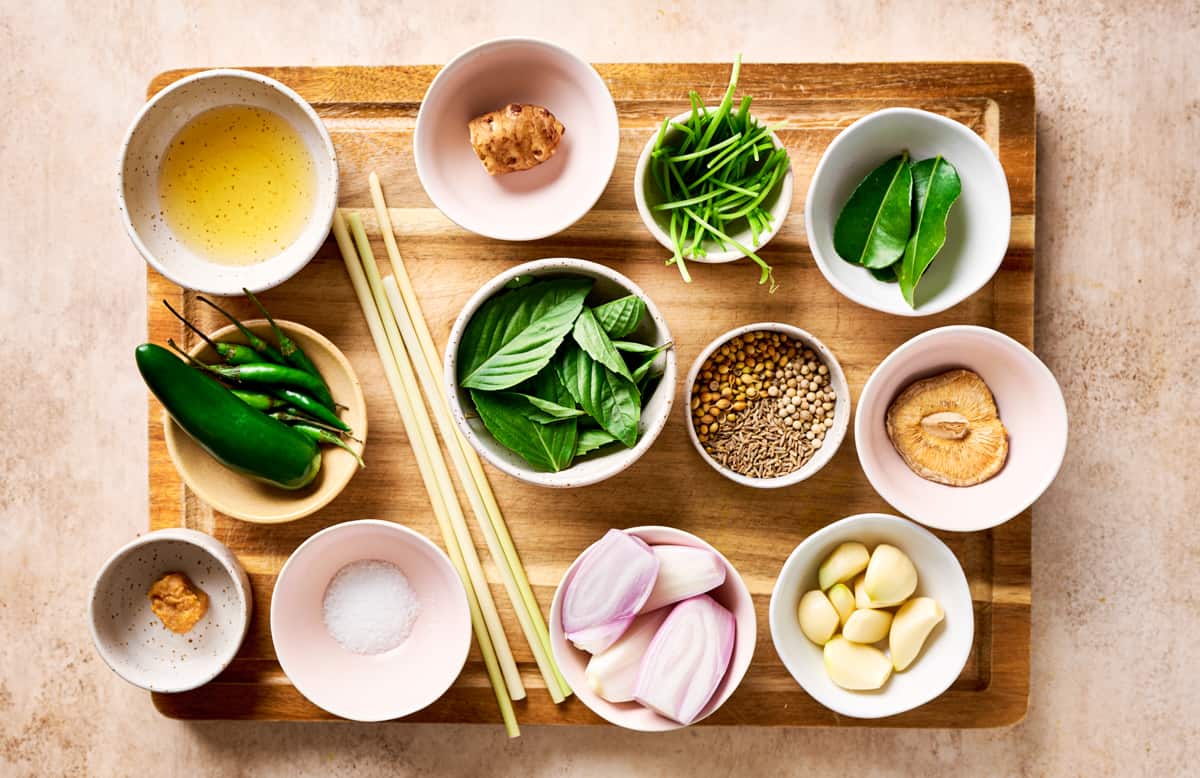
Frequently Asked Questions
Many (but not all) traditional versions of Thai green curry paste contain shrimp paste so they are not vegan, but many Thai restaurants make them vegan / vegetarian.
Here, a combination of salt, white miso, and dried shiitake mushrooms work excellently to bring all the salty, savoriness needed.
If you have a high-powered blender with a larger container, double or triple the curry paste (tripling is necessary for blender containers that are 64-ounce /2L or larger).
Technically, yes, you can use a food processor, but the paste won’t get totally smooth. The flavor is still excellent, so if you don’t mind some slight texture in your curry, feel free to use that.
Use a large, sharp knife to slice off the bottom tough nub from the lemongrass stalk, as well as the top tough green stalks.
Remove the papery outer layers from the remaining stalk until you reach the tender, flexible inner white core. If it feels like there are still firm, almost plastic-like layers, remove those because they will make the curry paste gritty.
Using a rolling pin, mallet, or the back of a heavy knife, smash down on the lemongrass to bruise it and open it up a bit, then mince, finely chop, or thinly slice with a knife (dependent on recipe instructions). If you have a mortar & pestle, you can pound it finely.
You can save some of the tough outer layers. Simmer in the curry for extra lemongrass flavor, then discard. Or, save and make lemongrass tea.
If you make a double or trip batch, store it in an airtight jar and refrigerate for 1 to 2 weeks, or freeze for up to 3 months.
After one week in the fridge, the color is less vibrant and the flavor is slightly muted, so for maximal flavor preservation, freeze if you don’t plan to use it in one week.
Lemongrass: Asian grocery stores and sometimes well-stocked grocery stores like Whole Foods and Albertsons sell it pre-trimmed.
Fresh lime leaves and Thai basil: Southeast Asian and some pan-Asian grocery stores. Lime leaves may be sold as “lime leaves,” “makrut lime leaves,” or “kaffir lime leaves.”
Galangal: Most Asian grocery stores, and definitely Southeast Asian grocery stores.
Bird’s eye chile peppers, AKA Thai chile peppers: some well-stocked grocery stores, as well as Asian markets.
Yes!
Lime leaves: Fresh lime leaves last about 2 weeks in the fridge, or can be frozen. Wash first, then dry very well so they don’t stick together. Then freeze. Prevent freezer burn by wrapping in foil first, then in a ziploc and remove all the air out.
Lemongrass: Trim off the bottoms and woody tops and peel away tough outer layers. Cut into 2 to 4-inch pieces. Transfer to a freezer-safe bag and freeze for a few months. To extend the shelf life, wrap lemongrass in foil first, then place in the bag.
Galangal: Slice thinly, then spread out on a plastic wrap-lined sheet pan or plate in a single layer to prevent sticking. Freeze, and once frozen, transfer to a freezer-safe bag and freeze.
Thai chile peppers: Freeze whole in a freezer-safe bag or container.
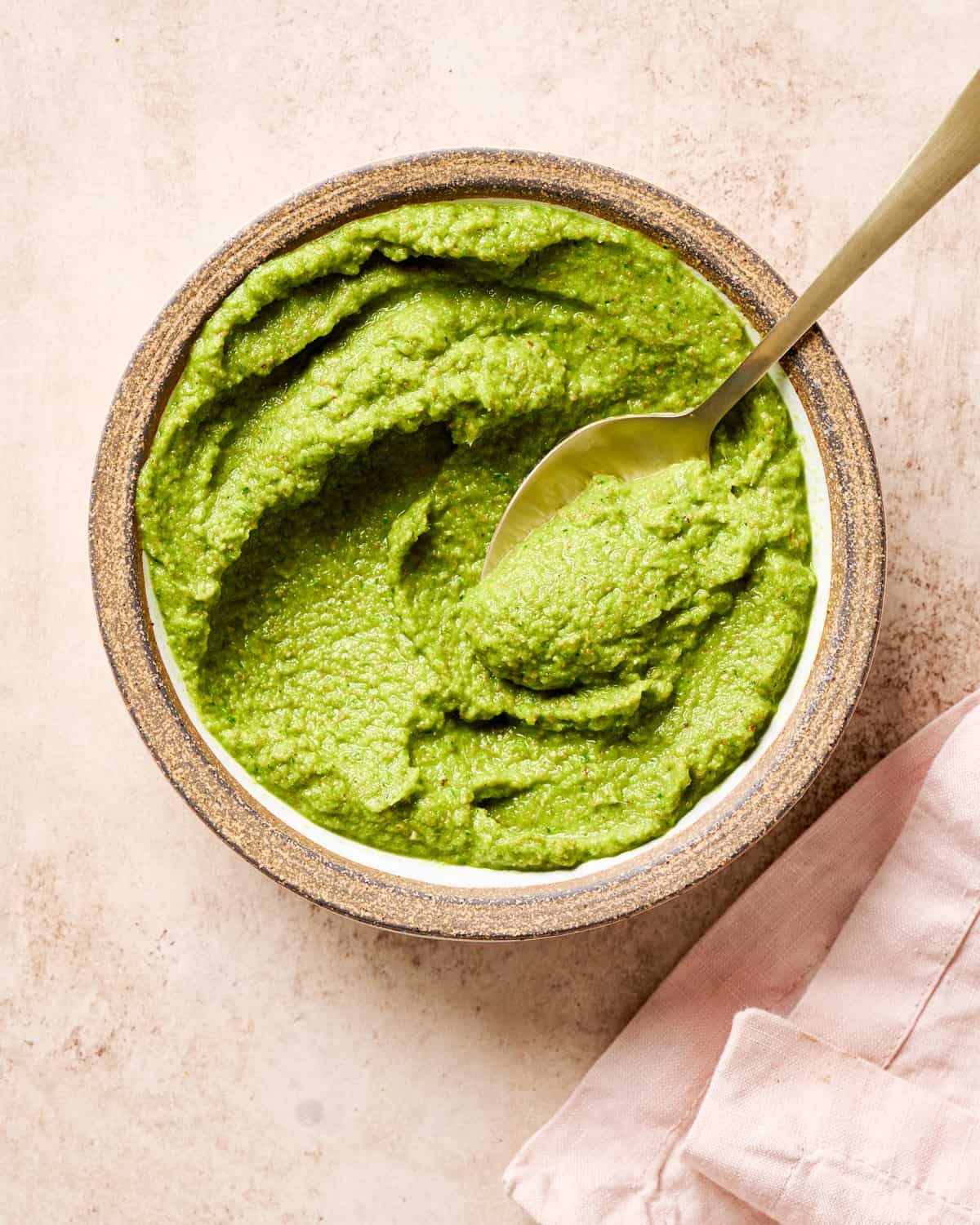
If love this Thai Green Curry Paste recipe, please give it a rating and review below! And of course, tag me with your remakes on Instagram!
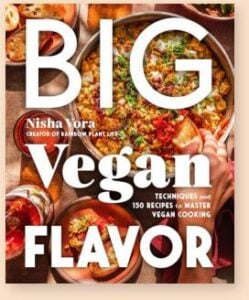
Big Vegan Flavor
Techniques and 150 recipes to master vegan cooking.
Homemade Thai Green Curry Paste
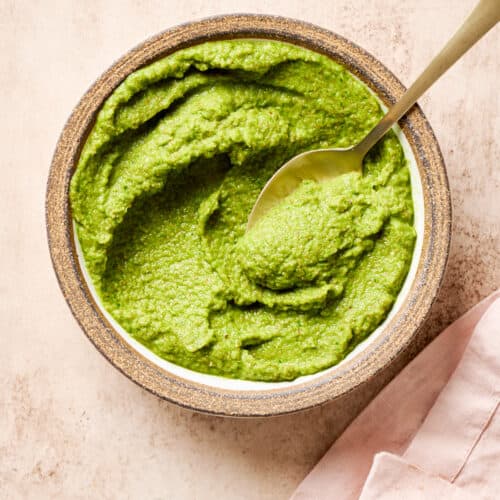
Ingredients
Spices
- 1 tablespoon coriander seeds (Note 1)
- ½ tablespoon cumin seeds
- 1 teaspoon white peppercorns or ½ tsp ground white pepper
Fresh Green Chiles (Note 2)
- 4 to 12 bird's eye green chile peppers (AKA Thai chile peppers), stems removed
- 1 to 2 jalapeño peppers, membranes removed and stems removed
Aromatics & Herbs
- 4 lemongrass stalks (about 15g minced lemongrass (Note 3)
- 1 ½- inch (4 cm) piece galangal (about 15g sliced) (Note 4)
- 2 medium shallots, peeled
- 8 garlic cloves, peeled
- 2 tablespoons chopped cilantro roots or stems (Note 5)
- 4 fresh makrut lime leaves, folded in half and middle rib removed (optional, Note 6)
- 20 Thai basil leaves (optional)
Other Ingredients
- 1 ½ teaspoons kosher salt (or 3/4 to 1 tsp sea salt), more to taste
- 1 teaspoon white miso paste (AKA shiro miso)
- 1 dried shiitake mushroom, grated with a microplane (for extra umami; omit if needed)
- 2 tablespoons neutral-flavored oil of choice (Note 7)
Instructions
- Toast the spices. Heat a small or medium frying pan over medium heat. Once warm, add the coriander seeds, cumin seeds, and white peppercorns (if using) and toast until darker in color and fragrant. Transfer to a bowl to stop cooking and cool. While the spices cool, prep your chiles, aromatics, and herbs.
- For the smoothest texture: grind the cooled whole spices using an electric spice grinder or mortar and pestle.NOTE: If you can't grind the spices before blending, the flavor is still great but the finished curry will have a less uniformly smooth texture.
- For lemongrass, slice off the top green stalks, the tough bottom nub, and peel away several layers of papery peel until you reach the tender inner white core (it should be soft and bendy). If you have a rolling pin or mallet, use it to smash down on the lemongrass to release more aroma.For the stand blender option: chop lemongrass (no need to chop finely).For the immersion blender option or mortar & pestle, mince the lemongrass or grate it using a grater or microplane.
- For galangal, use a sharp knife and cut off any hard knobs. Angle your knife as needed so you don’t cut through the root. No need to peel. For the stand blender option, slice or chop the galangal.For the immersion blender option or mortar & pestle, slice galangal very thinly.
- Blend the curry paste using either method below.If using a mortar & pestle, visit the instructions in the blog post "which tool is best for making curry paste?" If you want to taste the curry paste when it's done blending, taste just a tiny amount because it will be spicy! Add a bit more salt, as needed (it should taste salty).
High-Powered Stand Blender Instructions
- NOTE: You must have a high-powered blender with a small capacity blender (32 ounce / 1L or smaller). If your container is 48 ounces, you need to double the ingredients; if it’s 64 ounces (2L) or larger, triple the quantity.
- Prep lemongrass and galangal using the instructions above. Grate the dried shiitake mushroom. You can leave the other herbs and aromatics whole.
- First, add the oil to the blender so it coats the blades. Now add the remaining ingredients: chile peppers, toasted (ground) spices, lemongrass, galangal, shallots, garlic, cilantro roots or stems, lime leaves, Thai basil, salt, miso, and grated shiitake mushroom.
- Start blending on low, using the blender’s tamper to push everything down (make sure the blender lid is on when using the tamper). Stop the machine and use a silicone spatula to scrape everything down a few times. Don’t stick your face right over the curry paste, as it’s spicy and can make your eyes water.Gradually increase the speed to high, using the tamper to go up and down constantly. It should be smooth and look almost like pureed avocado by the end.
Immersion Blender Instructions
- Prep lemongrass and galangal using the instructions above. Grate the dried shiitake mushroom. Finely chop the chile peppers, galangal, shallots, garlic, cilantro roots or stems, and lime leaves. Tear the Thai basil leaves.
- Add the above ingredients to a wide-mouth mason jar or similar jar large enough to fit your immersion blender. Add the toasted, ground spices, salt, and miso.
- Now pour the oil on top of the ingredients. Place the immersion blender on top of the ingredients and push down to the bottom. Lift up, and using a spatula, scrape all the ingredients together again.
- Repeat this process until smooth; it will take several rounds and several minutes, so keep going. Don’t stick your face right over the curry paste, as it’s spicy and can make your eyes water.
Notes
Recipe: Nisha Vora / Rainbow Plant Life | Photography: Megan Morello
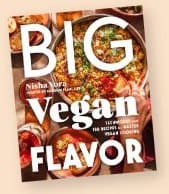



INCREDIBLE, as always from Nisha. Can I double this recipe and freeze the rest? Would it freeze well? Cannot wait to make again! And use this in the green curry chickpea salad from the meal plans!
nevermind! I found it within the post! This was seriously one of the best things I have eaten so I definitely plan to make more and freeze this!!! Thank you!!
Hi Paige, thank you for the lovely words! As you saw, this curry paste freezes well for up to 3 months! I like freezing curry paste like this in ice cube tray for easy use.
How wonderful! Thank you!
You’re welcome, Marsha!
Do you have a recommendation for a small capacity high-powered blender? I have a Vitamix and it’s too big for many small batches.
Hi Marsha, you can actually purchase a 32 oz vitamix container! Not sure what model you use, but here’s an example.
The curry paste smells good, tastes even better and is relatively easy to make.
Hi Lyz, we’re so happy you enjoyed it! Thanks for leaving a review :)